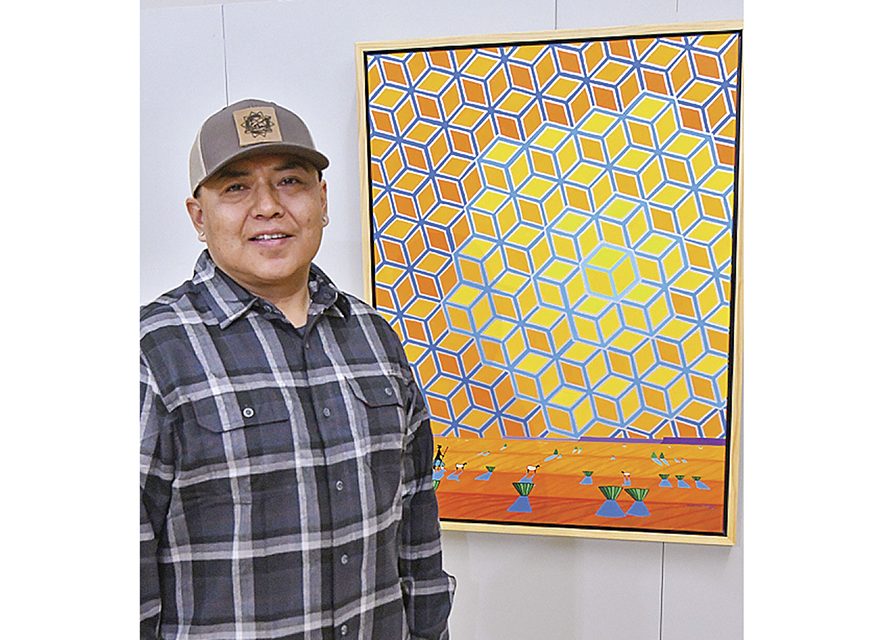
‘We are Diné’: Gilmore Scott painting the stories of Navajo landscapes and culture

Navajo Times | Robert Bettis
Gilmore Scott, the featured artist at Bluff Arts Festival, presents one of his canvas paintings featuring bright colors and geometric patterns that portray the Native landscape.
By Robert Bettis
Navajo Times
BLUFF, Utah – At this year’s Bluff Arts Festival, artist Gilmore Scott offered a glimpse into the natural beauty and cultural heritage of the Navajo people through his vibrant, contemporary paintings.
As a Diné artist, Scott’s work is heavily influenced by the sacred landscapes of the Navajo Nation, such as Bears Ears, Monument Valley, and Shiprock, which hold deep cultural significance for his people.
Scott is Tódích’íi’nii born for Kinłichíi’nii.
Though much of his work is inspired by Navajo tradition, Scott sees himself as a contemporary artist. His goal is to convey the stories of his heritage in a way that resonates with modern audiences, blending the timeless with the contemporary. Scott explained that his artistic journey was not instantaneous. It took him over a decade to develop the techniques that allowed him to express Navajo cultural stories, such as the male and female storms, in a way that would be both meaningful to his people and understandable to a wider audience.
“I definitely am not a traditional artist,” Scott said, stressing the distinction. “I’m just trying to take a different approach and convey who we are as Diné people.” His storm paintings, he says, don’t replicate the specific symbols taught in traditional stories, but rather offer an interpretation that captures the essence of those stories through color, form, and texture.
One of Scott’s central pieces at the festival features a lesser-known view of Bears Ears, a landmark that is visited by people from around the world. “Most people only see Bears Ears from the western side,” he said, referring to the iconic image of the twin buttes. “But if you swing around to the east, you see the full profile of the bear, with the snout forming from the landscape. That’s what I try to capture in my work—the perspectives people might miss but that we, as Diné, know deeply.”
Scott hopes that viewers at the Bluff Arts Festival will leave with a deeper understanding of his artwork and the wider spectrum of Indigenous art, which he believes deserves to be regarded as fine art rather than merely craft or souvenir. “We aren’t just tourist attractions,” Scott said. “There’s a slow transition happening where people are starting to see our artwork as fine art.”
For Scott, the festival is more than just a venue to sell his pieces—it’s an opportunity to share his stories with the community and educate viewers about the rich history and culture embedded in the landscapes he paints. “I enjoy explaining the stories behind my work,” he said. “It’s important for people to see that there’s real intent and meaning behind what we create.”
Over the years, the Bluff Arts Festival has become a key platform for Indigenous artists like Scott to gain recognition. Though he’s shown his work in galleries, Scott says he prefers being present with his art, engaging directly with the viewers to share the personal stories behind each piece.
As a contemporary Diné artist, Scott continues to push the boundaries of how Navajo stories are told in the modern art world. His hope is that visitors will leave with not only a deeper appreciation for his art but also a greater respect for the broader spectrum of Indigenous art that tells the story of a people and their connection to the land.








 Highway 264,
Highway 264, I-40, WB @ Winslow
I-40, WB @ Winslow